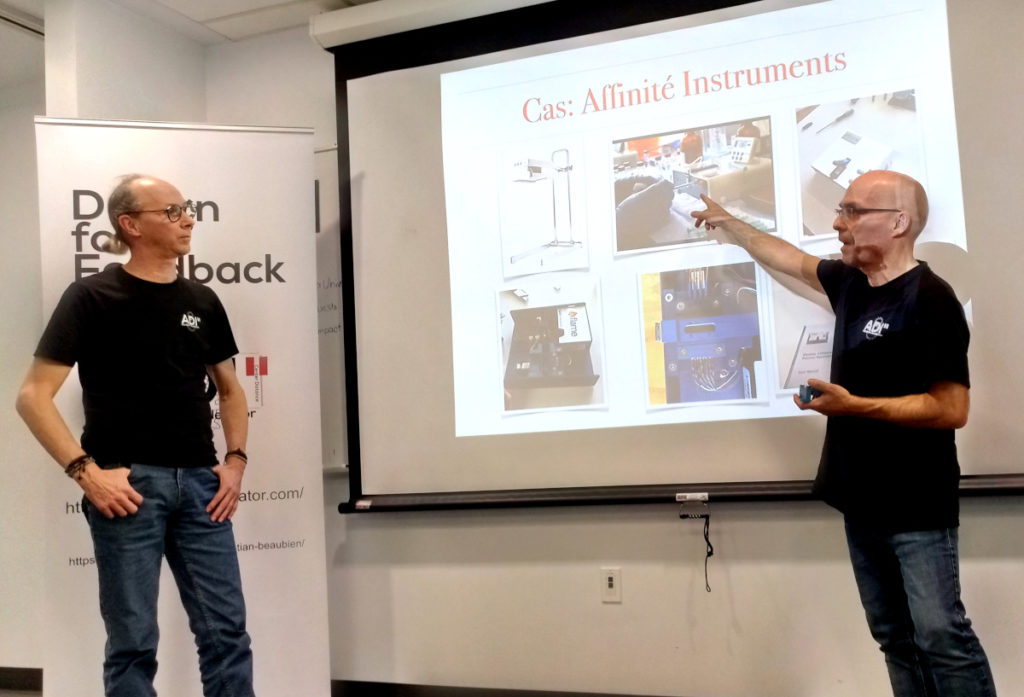Day 2 of District 3’s Biohealth Innovation Week (which I covered in some depth yesterday) was the main reason I registered, and it did not disappoint.
There were three main events scheduled, and I attended each:
- Product Development for Biomed and Biotech;
- Regulatory process and Quality Management in Biomed and Biotech sectors; and
- Emerging Technology Shaping the Future of Life Sciences
I’ll only cover the first, here, but it’ll be worthwhile to post on the others soon.
Product Development Workshop
Christian Beaubien and Stéphane Rousseau, of ADI Accelerator hosted a talk on product development.
You could summarize the entire workshop by saying: for early stage start-ups or whenever you are still fleshing out a concept, R3 Prototyping is where it’s at!
The term “R3” wasn’t even used in the talk, it’s just what kept popping into my mind as I listened to them describe the approach:
Really Really Rapid Prototyping.
Christian and Stéphane tag-teamed a rapid-fire presentation where they went over the concept of design thinking—hearkening back to the Design Thinking workshop from the day before—and drove home the idea that while you’re developing your product, the customer and funding always need to be at the forefront of your thinking.
Too often, the duo insisted, creators are aiming to get to a perfect, or at least nearly complete, solution prior to getting any feedback from the market.
This is not only costly and time consuming, it keeps them from failing fast and adjusting to the actual needs that are out there in the real world. It’s very easy to fall into this trap. At least for me, anyhow, as I’ll admit I’ve made this mistake (and sadly, more than once).
Better Than Polished: Pronto
Even doing your very best trying to empathize with your clients’ needs, it’s way too easy to get wrapped up in your own ideas and acquire a tunnel vision that leads down rabbit holes that just turn out being dead ends. In such cases you may feel very active (you are in fact working your ass off), but it is still effectively a case of preferring perfect inaction over imperfect action.
So when ADI is saying you should prototype quickly and show it off sooner rather than later, they really mean it.
If you’re doing some sort of proof of principle for hardware, you should leverage pre-built modules like a standard Arduino or Micro:bit and shields and other widgets.
But they take it further and showed convincingly, through case studies and war stories, how you can sketch out an app in keynote within a day or two, or even lay out your entire concept on a single sheet of paper and, using nothing else, discover the idea’s merits, improve and refine it, even in some instances secure million dollar contracts. With an outline on a single page… Ok, I’ll have to try that.

So the take-away was to use a lean approach to prototyping, sketch, assemble, scotch tape yourself something together and then run to a few potential clients (i.e. people who don’t know you and might actually spend money on such a thing or service) to show off your creation in order to collect some feedback and gather real data points.
Potential outcomes of doing so from perspective clients:
- “It’s the bee’s knees, please take my money” Ok, we all wish for this one—if it happens, you’re all set, start making it real and keep the iteration-feedback loop going;
- “That’s pretty cool, but would be even better if…” Try and improve using this real world feedback and come back with something more awesome for another round;
- “I have no use for this, though X might…” ADI has some examples where the product itself wasn’t the issue so much as who they were targeting—finding out who your clients are going to be turns out pretty useful, and showing the prototype around can point you in unexpected and better directions;
- “This sux pretty hard”… maybe someone else won’t think so, or maybe you can find out why and fix it;
- “This sux and I’m the only one anywhere who could possibly use something of this nature, so you’re done” Perhaps unlikely but apparently a recurring fear. ADI’s take: if showing off a shabby prototype risks alienating your only client(s), then there just aren’t enough potential clients for this anyway… next.
Here, negative feedback—whether its showing you what to fix/add/improve or that maybe this isn’t worth exploring much further—is more valuable than positive.
Partners On The Path
District 3 looks like an amazing team, has a ton of programs and seems like a hub of creation, activity, knowledge and fun. And it’s free! Amazingly, even with all the assistance and training they provide, they’ll keep their hands off your IP.
D3 can get you from concept to standing on your own legs and doesn’t demand a cut of the action… That’s worth checking out for sure.
However, owing to the arrow of time/ever increasing entropy/nature of the universe they’re naturally limited in the number of projects and entrepreneurs they can assist. Anyway, if you’re into the hardware scene, ADI may be a better fit.
ADI Accelerator are similar in that they act as a partner, and will leverage their experience to help you from design through to commercialization and production. As with District 3, the intellectual property you develop remains all yours.
One difference with D3 is that ADI is more specialized and focused on hardware-based projects—which is what I relish most. They’ll accompany you in doing design for feedback, iterating prototypes, strategic planning, small batch production runs of hardware and injection molding… basically everything you need to go from your first duct-taped-arduino proof of concept thingy to getting a finished product in the hands of your first clients, designed for manufacture and ready to scale.
Also (though this is just an impression based on very little since I’ve worked with neither to date), ADI feels a little less bureaucratic, a little more nimble. In any case, from what I understood, ADI and D3 work together and complement each other so maybe you can get the best of both worlds.
The main downside with ADI is (or might be) that they’re not subsidized and the work they put in needs to be paid somehow… i.e. by you. I’m not sure this is bad news, though…
On one hand, this makes them less shy than many sources: they seem more game to take chances (small/reasonable ones at least) and can move quickly. On the other, I think having skin in the game greatly encourages you to keep each step of the design for feedback stage as simple as possible, forces you to stay honest (killing bad ideas fast) and to move quickly towards solutions that meet actual needs real clients have.
Also, after conversations with both Stéphane and Christian, I get the feeling they are eager to try things and open to all sorts of arrangements. If you’re curious, get the ball rolling with the most “M” MVP you can put together, and drop them a line. They may be able to help you hone in quickly on real, useful, solutions that people want to buy such that everybody wins.
I’ve already reached out and am excited to meet and see what we can accomplish together.
